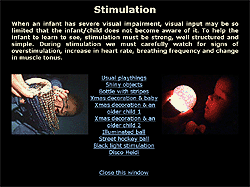Stimulation of Vision
 Stimulation of Vision videos
Stimulation of Vision videos
(Note that "Stimulation of Vision videos" is a new window. You get back on this page by closing the window at "Close this window" below the picture.)
Stimulation and Training of Vision
With stimulation of vision I mean use of strong visual stimuli to make an infant or child aware of vision. These children usually have very limited visual capabilities and no visually guided functions. As we see in the video sequences of this chapter the hands of each infant are involved in exploring the object. This is based on the findings on our monkey studies that demonstrated that tactile information might take over the cell groups that normally use both visual and tactile information if vision is not used during early development. If the infant gets strong visual input at the same time as tactile information is used to explore the surface qualities and form of the object, there is hope that the two different types of information can be integrated and start to support each other instead of competing.
When strong visual stimuli are used, overstimulation is possible and needs to be carefully avoided. Severely multihandicapped infants and children are constantly observed during stimulation but often also registration of pulse rate if needed to notice arousal.
Large projected slides I do not find useful because they may be beyond the child's visual sphere. They are difficult to comprehend without simultaneous information from other modalities and thus may not activate associative functions.
Picture perception is one of the most difficult concepts to develop when vision is abnormal. Therefore training in understanding pictures and their qualities should be included in the daily care of visually impaired children. First we choose objects that are well known by the child, like the shoes, and draw a picture around the shoe. Next the child can colour the picture and then we again compare the object and its picture.
Training of vision is an integral part of play and therapy situations. The content of the situation is the same as for normally sighted children but the visual information is clearer with good contrast so that it can be used for eye-hand coordination, eye-foot coordination, development of spatial concepts etc. In these training situations severely visually impaired infants and toddlers often use tactile and haptic information for quite some time to explore the surface qualities and the form of the object. This is sometimes diagnosed as stereotypic behaviour when it is not understood that tactile information requires equally many repetitions of observation as does vision to create a clear enough image to be remembered. - If a child looks for a long time at an interesting object it is not diagnosed as stereotypic behaviour!
In some visually guided motor functions a child may not reach the usual milestones so these particular motor functions need training. Also oculomotor functions can be trained as a part of occupational or physiotherapy. Specific short therapy sessions are planned in the meeting of the early intervention team using clinical findings and findings from the functional assessment as the basis for the program. During training the therapist can then make further observations and report them back to the team. Video recordings are helpful both in observation of visually guided motor functions and, especially, use of vision during interaction with family members and other children.
Vision therapy is not practised in Europe the way some optometrists and therapists practise it in the U.S. but visual stimulation and training are integrated in the child's early intervention program.